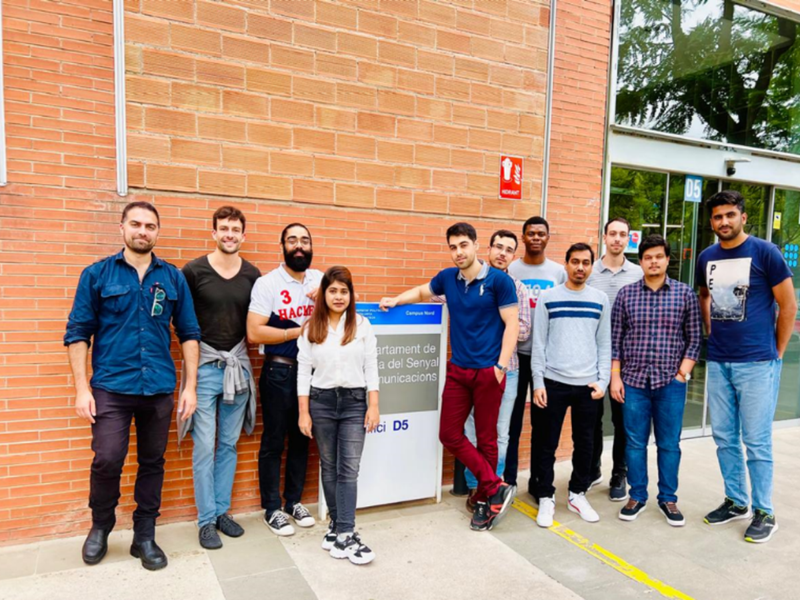5GSmartFact: Applications of Visible Light Communications (VLC) to the IIoT, by UPC PhD Student Sanjha Kahn
07/07/2025
5GSmartFact is an MSCA-ITN project funded by the EU whose objective is to work at the crossroads of factory automation and 5G evolution. We aim for a complete redesign of robot architectures that will lead to a leap forward in the industry automation
The project started in March 2021.
14 PhD students were hired at the beginning of the project, with different kinds of backgrounds (robotics, telecom engineering, …) and complementary PhD projects related with wireless communications and robotics. ESR (upc.edu).
Sanjha Khan is one of the 5GSmartFact ESRs pursuing her doctoral studies at the Universitat Politècnica de Catalunya (UPC), Spain, under the supervision of Professor Josep Paradells and Dr. Marisa Catalan, in collaboration with the i2CAT Foundation, Barcelona. Her research focuses on the application of Visible Light Communication (VLC) to IoT for indoor environments, leveraging low-cost CMOS cameras as VLC receivers.
She has developed a multi-camera VLC system that enables simultaneous communication and positioning for multiple IoT devices by combining image-based detection with time-division multiplexing. The system uses LED transmitters to send data and device identity information, which are captured and decoded from camera images for accurate positioning and data retrieval. Her work includes a novel method for integrating multiple CMOS sensors to enhance OCC-based VLC data rates, and the development of algorithms to improve 2D/3D positioning precision without requiring high-resolution images. She evaluated system performance in terms of Bit Error Rate (BER), as well as positioning accuracy for both static and mobile devices. These approaches were validated through real-world experiments using off-the-shelf hardware, demonstrating the feasibility and robustness of camera-based VLC in industrial environments.
OCC-based Visible Light Communication and Positioning
Optical camera systems offer advantages such as reduced electromagnetic interference and enhanced spatial reuse, but are constrained by the fixed frame rate of image sensors, limiting data throughput. To address this, UPC PhD student Sanjha Khan developed a multi-spatial receiver architecture using synchronized low-cost CMOS cameras to receive successive data bits in parallel. Her cost-effective prototype achieves a theoretical aggregated data rate of up to 1.6 Mbps across multiple cameras.
The system has been experimentally validated under varying indoor lighting conditions and distances, showing high reliability for short-range optical communication. Beyond improved throughput, this architecture also lays the groundwork for integrated positioning, removing the need for additional localization hardware or complex algorithms.
In parallel to communication, her research also addresses the challenge of precise indoor positioning using visible light. By analyzing the location and brightness of LED-emitted signals in camera frames, her system estimates the 2D and 3D coordinates of transmitting devices. She developed two key algorithms: A Non-Integer Pixel (NI-P) algorithm that identifies light spot centers at sub-pixel precision, eliminating the need for high-resolution cameras and reducing processing complexity. A 3D coordinate computation method that fuses spatial data from multiple camera views, enabling real-time 3D localization. This lightweight and scalable approach supports continuous tracking in dynamic environments, offering a practical solution for robust indoor localization using only low-cost hardware.

Fig. 1. 2D and 3D positioning algorithm (a) The actual light spot at a non-integer place (b) Pixel plotting at non-integer place (c) 3D positioning with two cameras
This work was carried out in collaboration with i2CAT Foundation in Barcelona, Robert BOSCH GmbH in Germany, and INGENIARIUS in Porto, Portugal, as part of the 5GSmartFact project funded by the European Union’s Horizon 2020 programme. Sanjha is currently in the final phase of her PhD, focusing on developing and validating a complete bidirectional VLCP system that enables both uplink and downlink communication, as well as ensures reliable 2D/3D positioning in dynamic industrial environments.

Fig. 2. Experimental Setups at BOSCH for static positioning testing and at INGENERIUS for mobile robot testing.
To know more:
[1] S. Khan, J. Paradells, and M. Catalan, "Low-Cost Optical Camera Communications for IoT," in 2023 IEEE 34th Annual International Symposium on Personal, Indoor and Mobile Radio Communications (PIMRC), Toronto, ON, Canada, 2023, pp. 1–5, doi: 10.1109/PIMRC56721.2023.10294012.
[2] S. Khan, J. Paradells, and M. Catalan, “Low-Cost 3D Indoor Visible Light Positioning: Algorithms and Experimental Validation,” Photonics, vol. 11, no. 5, p. 626, 2024.
Pictures:

5GSmartFact team activities at Universitat Politècnica de Catalunya, i2CAT Foundation and Robert BOSCH
Coordinator: Josep Vidal, UPC.
Consortium
5GSmartFact features a selected consortium of academia (Universitat Politècnica de Catalunya, Aalborg University), research centres (i2Cat, CNRS: Centre National pour la Recherche Scientifique), 5G companies (NEC, Nokia, Siradel) and expert companies in factory automation (ABB, Robert Bosch, Ingeniarius, Roboception), together with supporting institutions (Universidade de Coimbra, Université Paris-Saclay).
Funded by EU within the MSCA ITN program
Project website
https://www.linkedin.com/company/itn-5gsmartfact

Comparteix: